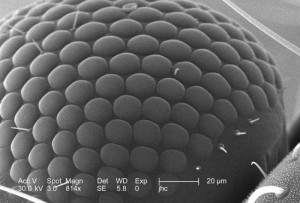

Optometrist Fort Collins Insect Eye Image
Picture of the week. This is an unidentified insect eye magnified over 800x by an electron microscope. It is an example of a compound eye, a primitive form where each sphere is a unit that is a cluster of photoreceptor light sensing cells. Imagine a small image for each sphere and you have the mosaic type of vision insects use, similar to a picture collage.
In our visual system we have two separate pathways, the magnocellular and parvocellular pathways. The magnocellular pathway comprises the minority of cells, under 20%. It accounts for the detection of motion. The parvocellular pathway is mcuh more prevalent and is used for fine details and color vision such as reading and computer work. In the insect world the magnocellular system is primary (bugs don’t read much)-and detection of movement is essential for their survival.
People who have traumatic brain injuries often have shearing of the visual nerve cells in the pathway and sometimes end up with a disruption between the two systems resulting in a mismatch between detail vision and movement. Sometimes special sunglass tints and prisms are used to slightly degrade the the parvocellular system and help resynchronize the system.
Soft contact lenses usually degrade the detail parvocellular systems resolution slightly but improve the peripheral vision or magnocellular system over spectacle lenses. Many patients feel like their vision is better with contact lenses than glasses, especially when they are active in fast sports like soccer and hockey where peripheral motion detection is so important.
(Photo by CDC/ Janice Carr)